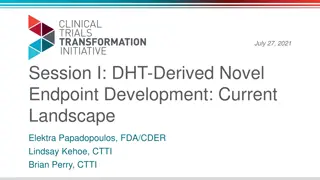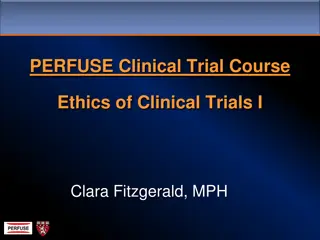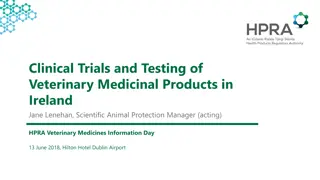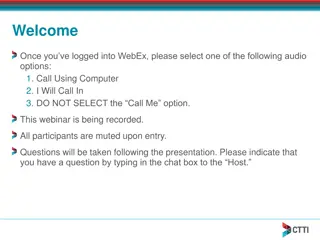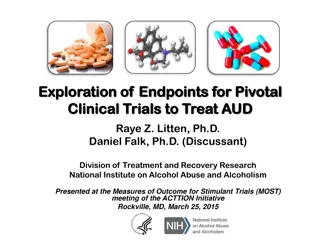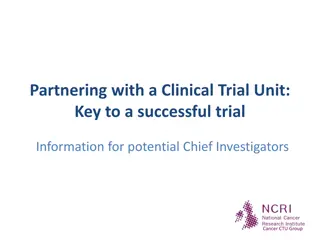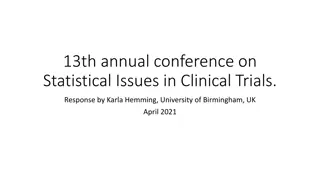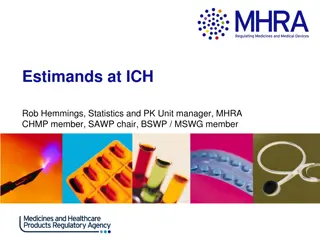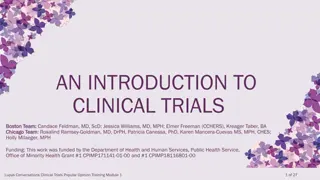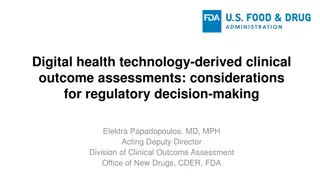Challenges and Recommendations for DHT-derived Endpoints in Clinical Trials
This study by CTTI explores barriers and solutions for adopting digitally derived endpoints in clinical trials. Through in-depth interviews with industry sponsors, the research identifies gaps, barriers, and recommendations for using DHT-derived novel endpoints as key endpoints in pivotal clinical trials. The trials described cover various therapeutic areas and phases, shedding light on the challenges faced in regulatory submissions and endpoint positions. Recommendations from sponsors aim to improve the endpoint selection process, DHT validation, and regulatory interactions.
Download Presentation

Please find below an Image/Link to download the presentation.
The content on the website is provided AS IS for your information and personal use only. It may not be sold, licensed, or shared on other websites without obtaining consent from the author. Download presentation by click this link. If you encounter any issues during the download, it is possible that the publisher has removed the file from their server.
E N D
Presentation Transcript
July 27, 2021 Barriers to and Recommendations for Adoption of DHT-derived Endpoints: Review of CTTI s Current Novel Endpoint Project Results Brian Perry, Social Science Lead, CTTI
In-Depth Interviews with Sponsors Trial Selection Criteria a clinical trial that uses a digitally derived endpoint to support or potentially support a label claim the digitally derived endpoint uses a digital tool to objectively measure a functional clinical outcome Focused on digitally derived endpoint positioned as either primary or secondary Objectives Describe the evidence used to support DHT- derived novel endpoints in pivotal trials for successful regulatory approvals. Identify gaps, barriers, and solutions to using DHT-derived novel endpoints as key endpoints in pivotal clinical trials.
Interview Participants: Demographics 11 interviews: 10 different industry sponsor organizations Primarily large-sized companies (market cap > $10 billion) 20 participants total Majority of sponsor companies reported few to no other known uses of DHT-derived endpoints as primary or secondary outcomes w/in their organization
Clinical Trials Described (1) Regulatory Submission Futility of investigational product Yes No Ongoing Endpoint position by trial phase n (%) 2 (18) Observational 0 2 1 1 3 (27) Phase 2 0 3 0 3 1 (9) Exploratory endpoint 0 1 0 1 2 (18) Primary or secondary endpoint 0 2 0 2 5 (45) Phase 3 0 5 1 4 1 (9) Exploratory endpoint 0 1 0 1 4 (36) Primary or secondary endpoint 0 4 1 3 1 (9) Phase 4 1* 0 0 0 1 (9) Primary or secondary endpoint 1 0 0 0 * Endpoint has been accepted in Europe only
Clinical Trials Described (2) Therapeutic areas included: neurology (5) pulmonology (2) rare disease (2) orthopedics (1) cardiology (1) DHTs used ranged from technologies that are widely available for consumer use to those intended just for clinical trial purposes
Topics Addressed in CTTI-led Sponsor Interviews Endpoint selection process DHT selection process Validation process Regulatory interactions and feedback Recommendations from sponsors
Sponsor Uncertainty Barrier What evidence do regulators expect? How can the development process be streamlined based on existing evidence and context of use? Can DHT-derived endpoints be used across other therapeutic areas? Do DHT-derived endpoints need to be comparable to existing legacy COA? What DHTs are appropriate to use? What COA development frameworks are appropriate? Recommendation Engage patients, caregivers, clinicians, and regulators early and often throughout the process
Qualification Process is Too Burdensome Barrier Clinical Outcome Assessment Qualification process is too tedious to invest in Current rate of DHT innovation outpaces regulatory review Risk of investing in developing DHT-derived endpoint outweighs the benefits
Qualification Process is Too Burdensome Recommendation Include DHT endpoints in early phase trials Select DHT that is fit-for-purpose ensure: There is a need for a DHT-derived endpoint The DHT is verified and validated for context of use The DHT is sensitive to measure meaningful differences
Lack of Appropriate DHTs & Experienced Vendors Barrier Limited availability of cleared DHT for COI/COU Limited availability of experienced DHT vendors to assist with clinical trial operations Recommendation Build partnerships with DHT manufacturers Analytically validate DHT algorithm as needed for COU Discuss with regulators about need Work with DHT manufacturer and/or other experts to develop appropriate algorithm, if necessary
DHT-Derived Endpoint Information is Not Shared Barrier Information about DHT-derived endpoints used in trials is not readily shared Algorithms and validation findings are considered proprietary Suggestion Participate in and contribute toward external collaborations Share trial results regardless of outcome
Interpretation of Meaningful Change is Challenging Barrier How do you demonstrate the DHT-derived endpoint is clinically meaningful if there is no direct legacy COA to anchor it to? Effect size?
Interpretation of Meaningful Change is Challenging Recommendation Include DHT endpoints in early phase trials and observational studies To inform optimal balance of data sufficiency while also limiting patient burden Compare DHT-derived endpoints in healthy volunteers to patient population; and/or patients with varying degree of disease severity Monitor patient compliance throughout the trial Include PROs and ObsRO to provide context for DHT use as well as direct measure of how change in endpoint is affecting patients
Basic Evidence Required DHT is accurate and reliable for a specific outcome within a similar context of use as the trial DHT is safe and feasible to use as intended by the patient population Endpoint is measuring a health concept that is meaningful Endpoint is able to measure change in disease progression or therapeutic effectiveness Change is similar (but not the same) to changes in legacy COAs Change is meaningful to patients, caregivers, and/or clinicians
Reflections from the Clinical Path Innovation Meeting (CPIM) July 16, 2021




